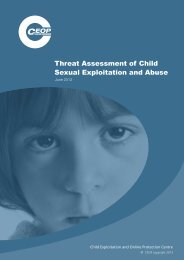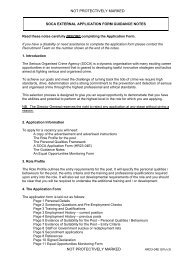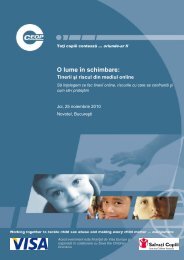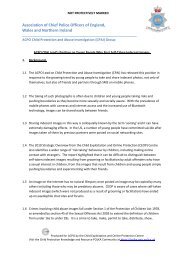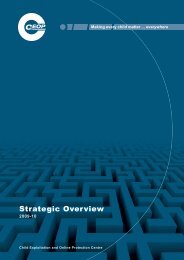The trafficking of women and children from Vietnam - CEOP
The trafficking of women and children from Vietnam - CEOP
The trafficking of women and children from Vietnam - CEOP
Create successful ePaper yourself
Turn your PDF publications into a flip-book with our unique Google optimized e-Paper software.
NOT PROTECTIVELY MARKED<br />
Children are <strong>of</strong>ten targeted by traffickers as they are deemed easier to manipulate than<br />
adults. More money can be earned by younger girls exploited in sexual exploitation,<br />
especially virgins. Pre-pubescent girls are reported to be injected with hormones to bring<br />
on puberty. Younger girls are expected to have a greater earning potential, <strong>and</strong> as such are<br />
in greater dem<strong>and</strong>. Where family connivance is suspected, a girl under 14 might adopt her<br />
older sister’s identity, so that she has identification papers. 17<br />
70% <strong>of</strong> all <strong>Vietnam</strong>ese victims <strong>of</strong> <strong>trafficking</strong> recorded by the UK’s National Referral<br />
Mechanism <strong>from</strong> 1 April 2009 to 31 December 2009 were <strong>children</strong>. 18 Children were possibly<br />
targeted for labour exploitation in the UK, because those identified by the authorities as<br />
minors are routinely transferred to non-secure local authority care where they can be<br />
pressurised by traffickers, either directly or indirectly through their families, into returning<br />
to exploitation.<br />
4.4 Recruitment<br />
<strong>Vietnam</strong>’s economic year-on-year growth has increased at a rapid rate. <strong>The</strong> distribution <strong>of</strong><br />
wealth, however, is uneven <strong>and</strong> skewed towards urban areas. This increases the economic<br />
disparity between cities <strong>and</strong> rural areas <strong>and</strong> contributes to rising unemployment in the<br />
provinces. This has resulted in increased internal migration to urban areas. <strong>The</strong> <strong>Vietnam</strong>ese<br />
government encourages unemployed people in rural areas to seek employment in overseas<br />
labour schemes. Such schemes can be <strong>of</strong> great benefit to individuals, receiving States <strong>and</strong><br />
the <strong>Vietnam</strong>ese economy, but many are poorly regulated. This creates an opportunity for<br />
organised criminal networks to traffic individuals with greater ease. Typically victims,<br />
themselves <strong>of</strong> low economic st<strong>and</strong>ing, come <strong>from</strong> small towns <strong>and</strong> villages in economically-<br />
depressed, rural areas with high unemployment. <strong>The</strong> IOM state that recruitment techniques<br />
vary depending on the province.<br />
Many people living in economically disadvantaged provinces <strong>of</strong>ten lack formal education.<br />
While it is compulsory to attend education until the age <strong>of</strong> 14, 40%-50% <strong>of</strong> rural <strong>children</strong> do<br />
not continue in education after they reach 14. <strong>The</strong> 2005-2006 Save the Children report<br />
identified that 93.5% (659) <strong>of</strong> victims had a low education level, including 90 (13%) who<br />
17 AAT<br />
18 A pr<strong>of</strong>ile <strong>of</strong> <strong>Vietnam</strong>ese Nationals referred as potential victims <strong>of</strong> Human Trafficking to the National Referral<br />
Mechanism 1 April 2009 – 31 December 2009. United Kingdom Human Trafficking Centre. Published March<br />
2010. Restricted<br />
Page 13 <strong>of</strong> 31



